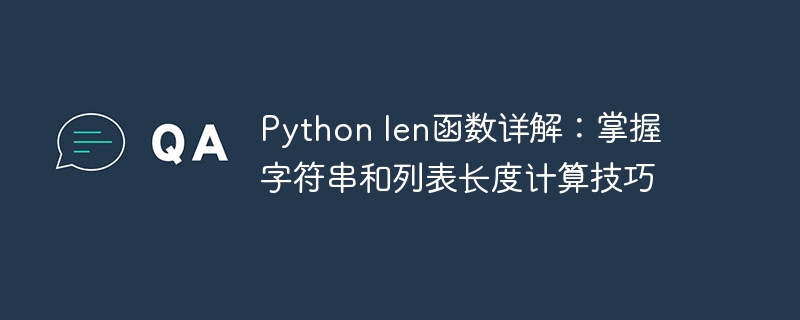Home >Backend Development >Python Tutorial >In-depth analysis of the Python len function: Master string and list length calculation skills
In-depth analysis of the Python len function: Master string and list length calculation skills
- 王林Original
- 2024-01-04 09:30:091379browse

Detailed explanation of Python len function: Master string and list length calculation skills
Introduction:
Python is a powerful programming language that provides many Built-in functions to help developers handle various tasks more efficiently. One of them is the len function. The len function is used to calculate the length of strings and lists. This article will analyze the use of the len function in detail and provide specific code examples to help readers better understand and master this function.
1. String length calculation:
In Python, a string exists in the form of an ordered collection of characters. The len function can be used to calculate the length of a string, that is, the number of characters. The following is a sample code for calculating the length of a string:
string = "Hello World" length = len(string) print(length) # 输出结果为11
In the above code, we define a string variable string whose value is "Hello World". Then, we use the len function to calculate the length of the string and assign the result to the variable length. Finally, we print out the length.
2. List length calculation:
Similar to strings, lists also exist in the form of ordered collections of elements. The len function is also useful for calculating the length of a list, that is, the number of elements in the list. The following is a sample code to calculate the length of a list:
list = [1, 2, 3, 4, 5] length = len(list) print(length) # 输出结果为5
In the above code, we define a list variable list whose value is [1, 2, 3, 4, 5]. We then use the len function to calculate the length of the list and assign the result to the variable length. Finally, we print out the length.
3. Notes:
When using the len function, you need to pay attention to the following points:
- The parameters of the len function can be any object with a length, such as a string , list, tuple, etc.
- The value returned by the len function is an integer type number.
- The length of an empty string or empty list is 0.
- If the given parameter is an object of non-string and non-list type, the len function will throw a TypeError exception.
The following is a sample code for non-string and non-list type parameters:
number = 12345 length = len(number) print(length) # 引发TypeError异常
In the above code, we try to calculate an integer number length. However, this raises a TypeError exception because integer types cannot use the len function to calculate their length.
Conclusion:
In Python, using the len function can conveniently calculate the length of strings and lists. Through the introduction and sample code of this article, we can better understand how to use this function. At the same time, we also need to pay attention to the parameter type of the len function to avoid exceptions. I hope this article will be helpful to readers and enable them to flexibly use the len function in actual development.
The above is the detailed content of In-depth analysis of the Python len function: Master string and list length calculation skills. For more information, please follow other related articles on the PHP Chinese website!

